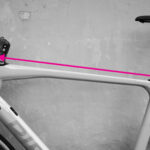Transporting your bikes safely and conveniently is crucial for any cycling enthusiast. Choosing the Best Bike Carrier For Car can significantly impact your travel experience, ensuring your bikes arrive securely and without damage. This guide reviews a range of bike carriers, from hitch-mounted to trunk and roof racks, to help you find the perfect solution for your vehicle and cycling needs. We’ll delve into different types and models, highlighting their pros and cons based on thorough testing and user feedback, so you can make an informed decision when selecting the best bike carrier for car.
Tray-Style Hitch Racks: Secure and Easy Loading
Tray-style hitch racks are known for their stability and ease of use, making them a popular choice for many cyclists. They hold bikes by their wheels, minimizing frame contact and accommodating various bike types, including electric bikes and those with unusual frame geometries.
Tray-Style Hitch Racks for Multiple Bikes (Two to Four)
For carrying multiple bikes, tray-style hitch racks offer robust solutions. Here’s a look at some popular models and their performance:
Hollywood Racks Destination E-Bike Rack for Electric Bikes: This rack is designed to handle the extra weight of electric bikes and folds flat when not in use, saving space. It includes a ramp for easier loading, which is a significant advantage for heavier e-bikes. However, the loading, unloading, and tilting processes can be cumbersome, involving multiple steps. Assembly is also more involved compared to some competitors. While more affordable, the Thule Epos might be a worthwhile upgrade for enhanced ease of use if your budget allows.
Küat NV 2.0: As a larger version of the Küat Sherpa 2.0, the NV 2.0 can be expanded to carry up to four bikes with an additional accessory. A notable feature is its integrated work stand, convenient for on-the-go bike maintenance. However, it’s considerably heavier at 56 pounds and comes with a higher price tag.
Küat NV Base 2.0: This model is similar to the NV 2.0 but without the integrated work stand. This makes it slightly lighter and more budget-friendly. Despite the cost and weight reduction, the Küat Sherpa 2.0 often presents a more appealing balance of features and usability for many users.
Thule T2 Pro XT (and T2 Pro XTR): The Thule T2 Pro XT, now replaced by the T2 Pro XTR (which includes wheels for easier maneuverability), was among the heavier and more expensive non-motorized tray-style racks tested. While Thule is a reputable brand, the weight and price point may deter some buyers.
1UP USA 2″ Heavy Duty Double: Highly rated in bike-club surveys, the 1UP USA 2″ Heavy Duty Double is known for its robust construction. However, usability can be less convenient compared to top picks. Releasing the clamping arm requires two hands, making bike loading and unloading slightly awkward. The tilt release handle is also less accessible. 1UP USA offers other models like the Equip-D in single and two-bike versions, but the Heavy Duty Double remains a core offering in their lineup.
Yakima HoldUp EVO: Heavier than the Küat Sherpa 2.0 and perceived as less refined in overall design, the Yakima HoldUp EVO showed more bike wobble during testing. Reaching the tilt lever was also reported to be difficult.
RockyMounts SplitRail LS: Mounting the RockyMounts SplitRail LS can be challenging, requiring a wrench for secure attachment. Its unusually wide profile can also make it cumbersome to handle. The included locks were noted as being short, potentially limiting their effectiveness on some bike frames.
Küat Transfer v2 2-Bike: Positioned as a more affordable alternative to the Sherpa 2.0, the Küat Transfer v2 2-Bike is heavier, requires more assembly, and lacks integrated locks. Critically, several batches of the Transfer v2 were recalled in June 2024 due to a pivot cam issue that could lead to bike detachment, raising safety concerns.
Thule T2 Classic: An older iteration of the Thule T2 Pro XT, the T2 Classic lacks the hitch receiver knob and convenient pull-handle tilting system found in newer models. It’s also heavier than comparable hitch racks and doesn’t include bike locks.
Saris SuperClamp EX (Four-Bike and Two-Bike): While the four-bike SuperClamp EX excelled in four-bike tray rack testing, its two-bike version didn’t stand out. The thinner mounting bar contributed to more sway compared to competitors, which is typical for loaded four-bike racks but less desirable in two-bike models where more stability is expected.
Yakima HoldUp: The Yakima HoldUp faced issues with stripped threads on the hitch receiver bolt, hindering secure installation. Although it tilts, rear door access on vehicles like a Toyota 4Runner may still be restricted due to handlebar interference.
RockyMounts BackStage: The RockyMounts BackStage offers both swing-away and tilt-down functionality for full vehicle cargo access. However, its significant weight (68 pounds) makes it less appealing compared to lighter alternatives.
Hollywood Racks Destination E-Bike Rack folded flat on a vehicle, a practical space-saving design for a car bike carrier.
Tray-Style Hitch Racks for Single Bikes
For solo riders or those needing a rack compatible with RVs or trailers, single-bike tray racks are available.
Küat Transfer v2 1-Bike: Previously recommended for solo riders, the Küat Transfer v2 1-Bike, along with most versions of the Transfer v2, was subject to a recall in June 2024 due to safety concerns.
1UP USA Quik Rack Single: The 1UP USA Quik Rack Single comes fully assembled but was found to be less user-friendly than the Küat Transfer. Operating the wheel hoops requires two hands, complicating bike loading and unloading.
RockyMounts MonoRail Solo: The RockyMounts MonoRail Solo presented a safety concern during testing. The tilt release handle was reported to snap back forcefully, pinching users’ fingers.
Hanging-Style Hitch Racks: Compact and Economical
Hanging-style hitch racks are generally more affordable and lighter than tray-style racks. They carry bikes by their top tubes, which may not be suitable for all bike frames (like step-through or some full-suspension bikes) without an adapter bar.
Saris Bones Hitch 2-Bike: Weighing the same as the favored Küat Beta, the Saris Bones Hitch 2-Bike was considered less desirable. Repositioning the support arms was less convenient, and bikes exhibited more wobble during driving.
Yakima RidgeBack: Fitting four bikes onto the Yakima RidgeBack proved challenging due to tight spacing. It also lacks a built-in lock, a feature often expected in its price range.
Thule Apex XT 4: The Thule Apex XT 4, while functional, does not fold flat for storage, which can be a drawback for some users.
Yakima HangTight: The Yakima HangTight is a vertical hanging hitch rack available in four- and six-bike versions, holding bikes by their handlebars. This design presented several issues. Lifting bikes into the rack requires grabbing near the chain and chainrings, potentially messy. It was incompatible with two out of four test bikes due to handlebar reflector and cable interference. Securing it to the hitch and adjusting height involves tools and is cumbersome.
Thule Apex Swing 4: The Thule Apex Swing 4, a swing-away hanging-style rack, allows cargo access without unloading bikes and is relatively light for its category (45 pounds). However, tray-style racks are generally simpler and more stable overall.
Yakima FullSwing: Another swing-away design, the Yakima FullSwing is significantly heavier than the Thule Apex Swing 4, making it less user-friendly during hitch receiver alignment.
Trunk Racks: Budget-Friendly and Versatile for Cars Without Hitches
Trunk racks are an economical option for vehicles without a hitch receiver. They attach to the vehicle’s trunk or hatchback with straps and hooks. However, they can be less stable and may scratch the vehicle’s paint if not properly installed and padded.
Thule Passage 2: Adjusting the Thule Passage 2 involves fiddling with spring-loaded snap buttons, which are considered cumbersome and offer limited adjustability.
Yakima HangOut: The Yakima HangOut was found to be more difficult to install and adjust compared to many competitors in the trunk rack category.
Allen Sports Deluxe 2-Bike and Ultra Compact 2-Bike: The Allen Sports Deluxe 2-Bike rack is difficult to install, and its arms are not adjustable. The Allen Sports Ultra Compact 2-Bike feels cheaply made, lacks durability, and exhibited significant shaking during driving.
Saris Solo: The Saris Solo, a single-bike trunk rack, is made of inexpensive plastic, lacks adjustability, and its fixed angle caused bike-to-vehicle contact in tests with a VW Jetta.
Roof Racks: For Occasional Use and Versatile Vehicle Applications
Roof racks mount bikes on top of the vehicle, either by the front fork (fork-mount) or by the wheels (wheel-mount). They keep the hitch free for towing or other accessories but require lifting bikes onto the roof, which can be challenging, especially for heavier bikes or taller vehicles.
Küat Trio: The Küat Trio is less user-friendly to mount than the RockyMounts SwitchHitter. It seems primarily designed for thru-axle bikes, and switching to a fork skewer was noted as tricky.
Yakima HighSpeed: While the fork-mount clamp on the Yakima HighSpeed is easy to tighten, assembling it every time a bike is mounted or dismounted is cumbersome. It also didn’t hold bikes as securely as some other roof racks.
SeaSucker Talon: The SeaSucker Talon is a fork-mount rack that uses suction cups to attach to the vehicle’s roof. Suction cups may not fit well on all roof types, especially those with raised ribs. When they do adhere, they can create significant roof flex under bike sway, as noted in user reviews.
Swagman Race Ready: While bikes can be locked to the Swagman Race Ready, the rack itself cannot be locked to the vehicle. It also offered less secure bike holding compared to top-rated roof racks.
Pickup-Truck Carriers: Specialized Solutions for Trucks
Pickup-truck carriers are designed for the beds of pickup trucks, offering various methods to secure bikes.
Thule Insta-Gater Pro: The Thule Insta-Gater Pro uses the truck’s tailgate for support and clamps onto the bike’s front wheel. It requires ensuring bike fit within the truck bed with wheels on, and tailgate lowering is restricted when the rack is in use. Wheel clamp security is crucial, as slippage can occur on rough roads, potentially leading to bike fall-over.
Yakima GateKeeper Tailgate Pad: The Yakima GateKeeper Tailgate Pad is a nylon-covered pad for truck tailgates, holding up to five bikes with front wheels over the tailgate and downtubes secured by Velcro straps. The Velcro straps were reported as too short for secure bike retention and could loosen on twisty roads.
Thule GateMate Pro Tailgate Pad: In contrast to the Yakima, the Thule GateMate Pro tailgate pad featured straps that were too long for many standard bike frames, making snug strapping difficult. Thule indicated these straps are designed for modern mountain bikes with larger frame dimensions, making it less suitable for general use.
Conclusion: Choosing the Best Bike Carrier for Your Car
Selecting the best bike carrier for car depends heavily on your specific needs, vehicle type, and budget. Tray-style hitch racks generally offer the best combination of security and ease of use, particularly for frequent cyclists and those carrying various bike types. Hanging-style hitch racks are more economical and suitable for lighter use. Trunk racks provide a budget-friendly option for cars without hitches, while roof racks are versatile for occasional transport and keeping the hitch free. Pickup truck carriers offer specialized solutions for truck owners.
Consider factors like the number of bikes you need to carry, bike type, ease of loading and unloading, security features, and storage when not in use. By carefully evaluating your requirements and reviewing the options, you can confidently choose the best bike carrier for car to enhance your cycling adventures.
Edited by Christine Ryan.


